- Home
- Peter Matthiessen
The Cloud Forest Page 15
The Cloud Forest Read online
Page 15
The bird life, as on the Amazon, is complex and colorful, and the air is never empty of bird sound, interweaving in a kind of counterpoint the chant of tree frogs and cicadas: a black bird with a bright reddish beak had a sudden strange melodic ring, and I noticed especially a dark, striking blue and green parrot, a dark flycatcher, white-bellied and scissor-tailed, another dark flycatcher with a white head stuck onto its body like a ping-pong ball, and an emerald-backed and rufous-bellied bird, white-chinned and long-beaked, luminescent as a hummingbird. This bird, I believe, is one of the motmots.
But the remarkable thing here is the variety of biting insects, and especially ants. There are large black flat-headed ants, and large black ants with both pincers and tail sting (these are apparently cannibalistic, and can be seen on all the trails, sometimes three together in silent, murderous struggle), and leaf-cutting ants, and small black ants, red ants, and white ants: the red ants include the fire ants, a few of which, at the suggestion of my missionary companion, I placed experimentally on my hand. Immediately, with a rare unison of ill temper, and little bodies all doubled up with the effort, they drove their stings into my skin, producing the sensation which gives them their name. Later we opened a large termite mound under attack by fire ants: the latter roamed up and down the exposed tunnels, seizing up and making off with the larger bodies of their pale relatives. A kick or two delivered at the base of the mound brought the fire ants out of the holes in awesome swarms; they resembled a red foam, tumbling over one another and pouring down and around the sides of the mound in search of the tormentor. They then fanned out into the grass, and we retreated.
There were also an imposing blue hornet—“Now that one’s got quite a sting to him,” Austel said—some bees and ticks, and the remorseless mosquitoes and borrachudos, the tiny black pium fly which leaves a dark pinpoint of blood at the surface of the skin.
Of poisonous snakes the island has very few, but the onca, or jaguar, is common here—Tom Pope, Austel’s affable partner at Macauba, saw one on the river bank only a few days ago—as are deer, capybara, and peccary. Another common creature, in its black, white, and red-throated varieties, is the piranha, and my experience at Macauba strongly supports the prevailing theory that this fish almost never attacks except when there is blood or other wound fluid in the water. The whites and Indians swim readily in the river, and come back to the same place to catch piranha: experimenting, I caught a pugnacious, toothy specimen of two pounds or more in the exact spot where I had dived five minutes before, and a moment later caught a second, smaller one. The following afternoon we went swimming again. The Austels’ little boy, with the other children, remained in the water after the rest of us had come out. He had a cut, nearly healed, on one thumb, and suddenly we heard him scream. He was rushed from the water with a bleeding hand, the thumb severely bitten by a piranha.
There are two Caraja aldeas near Macauba, and we visited these one afternoon in the mission launch, a long, outboard-powered craft built by the Indians. One aldea, consisting of three huts, lies on a high sand beach on one of the river islands, and the other, slightly larger, across the river on the Mato Grosso shore: behind the latter low mountains rise out of the wet savannas, the Serra de Araia, and faraway to the west, toward the Xingú, another sierra which I would have identified, according to my map, as Fawcett’s Serra de Roncador if I had not read in Peter Fleming’s Brazilian Adventure that this range does not exist. This village is the only settlement of Carajas in Mato Grosso and exists in the shelter of a nearby frontier settlement of Brazilians; this region of the Mato Grosso is ruled by the fierce Kayapos, of whom the Carajas are terrified, and who fight instead with the Brazilians and with another people of this region, the notorious Xavantes (this “x” is pronounced “ch,” and so is the “t”; hence, “Cha-van-chees” ). The Kayapos and Xavantes are alike in that both were driven from eastern Brazil into Mato Grosso; the Xavantes, in fact, are the unconquered element of a peaceable tribe of the Tocantins called the Xerentes. They are also alike in that they are shot down frequently by the frontiersmen of Mato Grosso, where in 1953 the ambush and massacre of twenty-two Xavantes—just after this band had been peacefully “contacted” by Brazil’s dedicated Indian Service—has undone years of painful effort. An Indian raiding party wiped out an entire family of settlers only a few years ago, and skirmishes continue. The fine Brazilian law (sponsored originally by General Rondon, who traveled this wilderness with Theodore Roosevelt) prohibits the killing of Indians for any reason, including self-defense. (I say “fine” because it is precocious for South America, where the majority of governments, officially or otherwise, still exterminate Indians who become a nuisance.) But the law is not always observed in Mato Grosso, despite the fact that the crime of killing an Indian is far more serious than the crime of killing a Brazilian; the latter, to judge from attitudes in Goiás, is scarcely considered a crime at all.
Otto Austel, who is devoted to the Indians, is also sympathetic with the settlers of Mato Grosso. They are the pioneers, the bandeirantes, of Brazil, yet apparently they receive little or no cooperation from the government, being treated as squatters and even outlaws—which of course many of them are. This morning on the trail we talked to a handsome booted Brazilian who is a wanted killer—though it must be remembered that the term “killer” in these parts describes a fair percentage of the male population and lacks our own pejorative connotation. In any case, the settlers move civilization forward at great risk and hardship, only to be ousted by the “owners,” who take over the land once the coast is clear. The settlers then move farther into northern Mato Grosso, which is still all but uninhabited.
The frontier settlement across the river, with its traders, its alcohol, and its Catholic priest, is rather troublesome to Macauba, since the Carajas have the traditional small tolerance of their race for alcohol and wander readily from the paths of righteousness. Usually, however, it is outsiders who cause trouble. One night while we were standing on the bank an Indian from across the river appeared in his canoe and announced his intention of killing his wife, who had fled to her family on the Macauba side; he wanted her back, dead or alive. Being badly outnumbered, he lay smiling oddly in the stern of the canoe until such time as he was invited, or became drunk enough—he had a bottle of pinga in his hand—to venture ashore. The invitation would have to come from the female head of a household, who would then carry his rifle for him and lead the way. The rifle lay in front of him in the canoe. It was plain that he meant to come ashore sooner or later, and the aldea was very uneasy. It was decided to invite him, and an old woman took up the rifle. At this point Austel and Pope, who let the Indians settle their own affairs whenever possible, decided to intervene. Austel, who knew the man, approached him as he came ashore. Hugging and cajoling him, he confiscated a stiletto and, after a brief struggle and last snort, the bottle. Then he took the rifle from the woman, promising to return all these things whenever the man should decide to leave. At this point Pope placed a very large arm, both comforting and restraining, on the man’s shoulders; he stayed with the Indian until later in the evening, when the man sobered and was persuaded to depart.
The village is most upset, however, by even the faintest prospect of attack upon them by the Kayapos; even in their own accounts of famous Kayapo-Caraja battles the Carajas invariably lose, and they see no reason why things should be any different now. Actually, a modern skirmish would be most unlikely: though there are periodic alarums, probably baseless, there has not been a battle for years. The Kayapos do not use canoes and would have to swim across to Bananal, fully armed, eluding the vigilance of the numerous and noisy araras and dogs: should they have to retreat, they would be wiped out in the water. On the other hand, the Kayapos fight to gain prestige and welcome a disadvantage. Unlike the Xavantes, who in war are said to admire stealth and treachery above all other virtues, they rarely attack when they have the upper hand and prefer open combat, declared in advance.
One night Georg
e Glass showed the Indians colored slides, including several photographs of themselves. The latter they took in their stride, giggling a little, and they gazed admiringly, for the first time in their lives, at pictures of cities, of the sea, and of an ocean liner, all identified for them by Otto Austel. But curiously—and this was somehow moving—they were affected most by pictures of wild animals and birds, the egrets, ocelots, and monkeys with which they were familiar. Several men jumped up and pantomimed the bow and arrow, aiming at the screen, and the rest called softly their strange cry, which can be heard great distances through the forest—coo-ee-e—or hooted their rich, infectious laughter, like the joyous hooting of Negroes.
The following night two Indian men demonstrated under the moon the dances of their festival. They wore costumes of straw surmounted by very tall eyeless masks worn like hats, so that the figures seemed huge and faceless, blind. Straw scraping and bare feet slapping on the bare mud, gourd rattles in their hands, they tottered and heaved in time with each other, up and down, up and down, bumping and shuffling and uttering unearthly groans, the steps changing with the several changes of costume. They represented spirits, both beneficent and malign, and the huge apparitions are designed to frighten the women of the tribe and keep them in their place. While few Indians still take the spirits seriously, the men are as foolish about their lodge and its rituals as are our American “joiners,” and their taboos are more severe: women who venture near the costume lodge are punished by multiple rape, and a dancer who lets his human identity be known may be put to death, though he is let off if his sister will offer herself to all the medicine men. (The now extinct Onas, thousands of miles away in Tierra del Fuego, had an almost identical custom of male lodges and ritual dances, with the same purpose; nosy Ona women, however, were put to death.)
The dancers this evening were both converts to Christianity, and while Austel felt certain that the tribe now takes the whole business as a joke, one had to wonder. If the odd, fervid groaning and shuffling of the straw giants in that jungle clearing, against a dim palm hut and black wall of trees, stirred a certain primordial dread and exaltation in a hard-eyed modern like myself, what must it do to people who until quite recently lived in the world of darkness and inarticulate fears which these figures represent? The Indian superstitions, after all—and I hope my friends at Macauba will forgive me—are no more incredible than the miracles they are asked to accept instead, though the airplane and penicillin have made the evangelists the greatest medicine men who ever lived.
Leaving Macauba, George Glass flew eastward to the village of Gurupí, which lies on the jungle highway north to Belém. We crossed the north half of the island, glimpsing a few whirring bands of parrots, the tireless urubus, and the sharp white outlines of egrets and storks. There was also a solitary deer, frozen in a swampy pool. Javahe huts appeared, and then the dull coils of the branco menor of the Araguaya, stuck on the flat, flat land. The far side of the river here is similar to the island, a great meadow with soft woods and streams, very peaceful in appearance from four thousand feet. But the plane slid down for a better look, and then the chaotic tangle could be seen in the vines and trees, and the meadow became marshes and morose bogs. This is the country of the savage Canueiras, who are said to kill whites and strange Indians on sight. Though Glass has flown this route before, he has never seen a trace of these Indians, and we watched avidly for a clearing or hut or trace of smoke. And then we saw something—a crude plantation hacked out of the jungle at the edge of a slough. Behind it, deep in the trees, a large hut stood almost hidden, and at the plantation edge, two ragged shelters. But the hut was well thatched, obviously inhabited. Several times Glass buzzed it closely with the plane, but nothing moved. The lifelessness, indicating flight into the trees, as well as the hut’s location and the absence of visible trails, strongly suggested Canueiras: a lone Brazilian settler would be adventurous indeed to invade Canueira territory, and certainly he, or his family if he were absent, would come out and wave at a low plane. But there was nothing, only a breathless stillness, silence, palpable above the dry hum of the airplane, as if the jungle here were petrified. And it occurred to me that the dread Canueiras, terrifying to the Javahes, kill on sight not because they are warlike, as are the Kayapos, but because they are terrified themselves. Nevertheless, I kept an attentive ear on the plane’s engine, not being anxious to terrify them further by a forced landing.
“Wait until I tell Otto about this,” George said; he went on to say that Tom Pope wanted to try to reach the Canueiras, and I could not help but think how similar Tom seems to the five men who approached the Aucas in Ecuador, as described by one of their widows. How moving that account was, and yet exasperating: the faith which carried them far beyond the limits of courage and adventurousness, which made them, in the most literal sense, damned fools.
We took on gasoline and a breakfast of coffee and bananas at Gurupí, where a giant frog sat in a post hole near the airplane. Then we flew south, climbing up out of the lowlands and striking a violent rainstorm: the squalls of rain stood like pillars of pale marble across a ruined landscape. The squalls surrounded the plane quite suddenly, and a clatter of hail seemed to beat it toward the earth. But the plane fought clear after detouring to the westward; already we were over the rough cattle range of Goiás. A large ostrich, large as a deer from above, passed between two trees. Yellow bell flowers of the ipé tree speckled the harmonies of green, and tall buriti palms, with their short fronds, stalked down the grassy water courses. But the marks of this country are the huge smooth black boulders surging from the earth, some flat in the grass, others looming out above the trees in the small woods, like backs of wet elephants. Ahead, the low mountains of the planalto formed in the clouds: Glass gave me the controls of the plane, and I steered her south uncertainly toward Goiania, unable to get that one hut in the Canueira country out of my mind.
March 12.
Today it is raining across Goiás. The small transport out of Goiania taxis roughly over fields of clouds, sinking down again into the swirl just east of the Araguaya. The plateau is broken by remarkable ponds, a series of them, identically shaped, like tears, and then the Araguaya, narrow and turgid here, winding off northward through the rain to Bananal, the Tocantins, the Amazon, and the sea. This is the Serra das Divisões, which forms a sort of east-west continental divide: there are many streams, their headwaters often but a few miles apart, yet those on the north side of the plane will end eventually in the Amazon, those to the south in the Paraná and Paraguay and, eventually, the River Plate.
The plane careens into the airstrip at Aracaras, the very first scenic attraction of which, seen at close hand just as the wheels touch the mud runway, is the wreck of a plane very similar to our own. A minute later we are waved into place before the humble terminal by a ground man with bare feet. The next air strip, at Guaratinga, in Mato Grosso, has no ground crew at all, and its terminal building is a hut of daub and wattle. My memories of Guaratinga will be two—a pair of small owls looking like quail, which I startled from a bush by the runway, and the take-off procedure of the pilot, a gay, abandoned sort of fellow, who kept the clumsy two-engined plane less than fifty feet from the ground, buzzing and swerving, for several miles across the roughest kind of upland country. Terror was general among the passengers, but as I speak no Portuguese and the rest were country people, already bewildered by their trip, no one dared say a thing.
We are now well into Mato Grosso, on the planalto, and the nondescript mountains of Goiás have changed rapidly to buttes and tablelands, pinnacles and escarpments, the sort of formations one expects to be bleak and rocky but which, here, are wooded. This is the country of the Borora tribe. Though there are areas of scrubby highland where the red earth gleams through the thin foliage, most of the woodland is dense, dense as green sheep wool—mato grosso.
From the village of Poxoreu, nestled among buttes, we fly on to Cuiabá, the capital of Mato Grosso and the town from which Fawcett set off on
his last, fatal expedition: a little to the north of here lie the headwaters of the Xingú and the land of the Xavantes. From Cuiabá, the river of this name flows southwest to the Paraguay, and our next stop, the village of Cáceres, is on the Paraguay itself: from Cáceres, the plane heads due south to its final destination at Corumbá, on the Bolivian border. (In Spanish, the names of these three last-mentioned places would be accented on the second syllable, but in Portuguese, they are accented on the last syllable except in the case of Cáceres, which is accented on the first: this is one of the least important reasons why the two languages, quite similar when read, are actually so difficult to reconcile. Brazil is the only country in South America which uses Portuguese, and if one’s Spanish is precarious, as mine is, one should not risk losing it altogether by attempting to speak Portuguese as well. With the sole exception of obragado, a useful word meaning “thank you,” the thing to do is to go right on speaking your wretched Spanish as if you imagined it was the native tongue, thus keeping your opponent on the defensive. With a little sign language to help him out, the Brazilian will get enough of it to help you keep from starving to death, and his gargled response—the voice is that of a person angered while eating macaroons—will be a total loss in any case.)
South of Cáceres the planalto dies in a series of steep ridges, narrow to the base, like man-made walls; these sink in turn into a great pantanal, or marsh, which, surrounding the upper Paraguay, extends between three and four hundred miles north and south and nearly two hundred east and west: while most of it lies in Mato Grosso, it overflows into eastern Bolivia and northeast Paraguay as well. This would seem to make it the greatest fresh-water marsh in all the world (at least, I can’t think of one larger, though I shan’t lack for somebody who can). In any case, it is a remarkable place, so remarkable that its obscurity seems astonishing. A tourist bureau, I suppose, might hesitate to recommend a swamp, and especially a swamp which lies, it must be said, a considerable distance from the beaten track. Nevertheless, it is worth going out of one’s way to see, for it is a natural phenomenon quite as beautiful as high mountain or rocky seacoast. Or at least it is beautiful in this season, when the waters are high enough to create the swamp but not so high as to make an inland sea. Because the pantanal absorbs a hundred streams, the water is kept moving: it is clear, a gleaming black, free of stagnant algae and miasmic slimes. The grasses of its savannas are a fierce, fresh green, as are the beds of floating plants, looking from the air like dense water hyacinth. The variety of grass is broken by shady islets of pretty trees, and neat canals running among the water plants, and ponds which open into lakes, and out of the lakes, farther to the south, the blue hills of low ridges—everything in harmony and in place, without the usual swamp clutter and decay, under the bright sun of the central continent. The pantanal is trim as a deer park and looks infinitely hospitable, though it is not: it is trackless and fiercely hot, and it abounds in insects, piranhas, and large caimans. Its high ground, in the dry season, supports cattle—the region produces quantities of the South American dried beef, called charque—but otherwise it is inhabited most notably by jaguars, and by a remarkable tigrero named Sasha Siemel, who hunts these animals with a spear.

 Lost Man's River: Shadow Country Trilogy
Lost Man's River: Shadow Country Trilogy The Tree Where Man Was Born
The Tree Where Man Was Born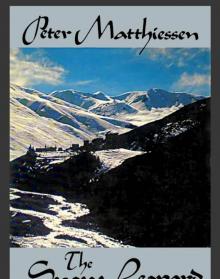 The Snow leopard
The Snow leopard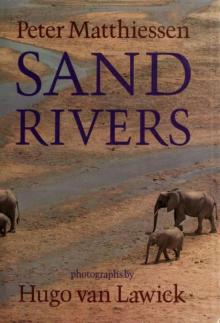 Sand Rivers
Sand Rivers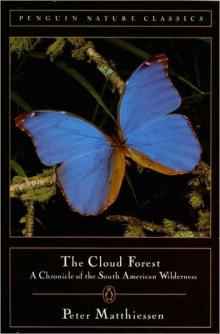 The Cloud Forest
The Cloud Forest Sal Si Puedes (Escape if You Can)
Sal Si Puedes (Escape if You Can) Far Tortuga
Far Tortuga Men's Lives
Men's Lives On the River Styx: And Other Stories
On the River Styx: And Other Stories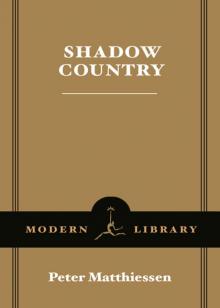 Shadow Country
Shadow Country At Play in the Fields of the Lord
At Play in the Fields of the Lord Lost Man's River
Lost Man's River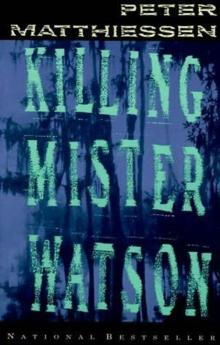 Killing Mister Watson
Killing Mister Watson On the River Styx
On the River Styx